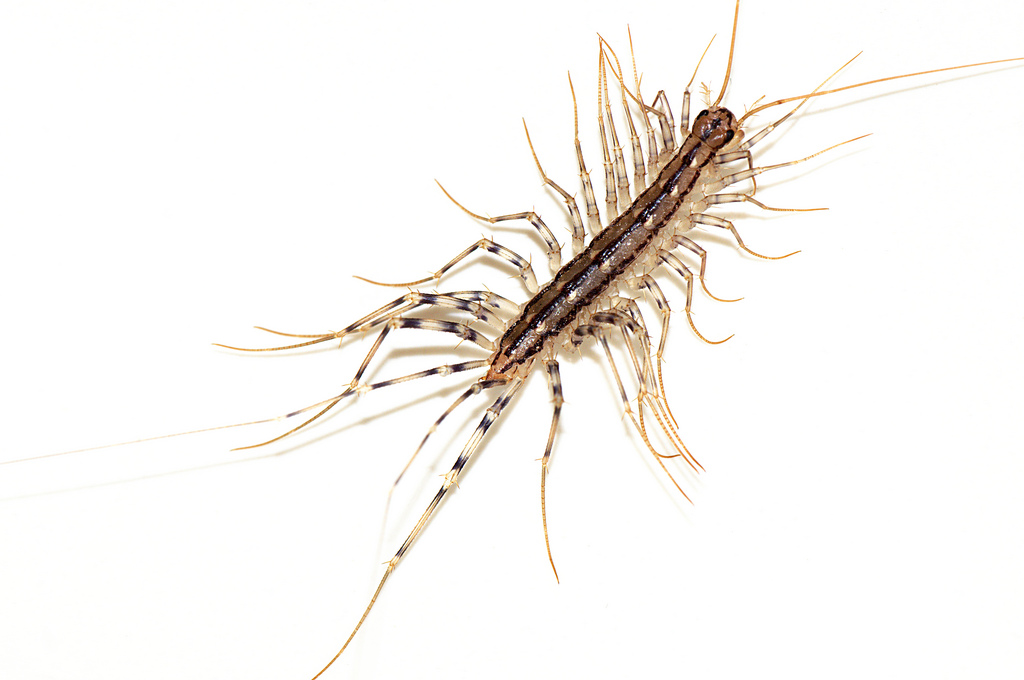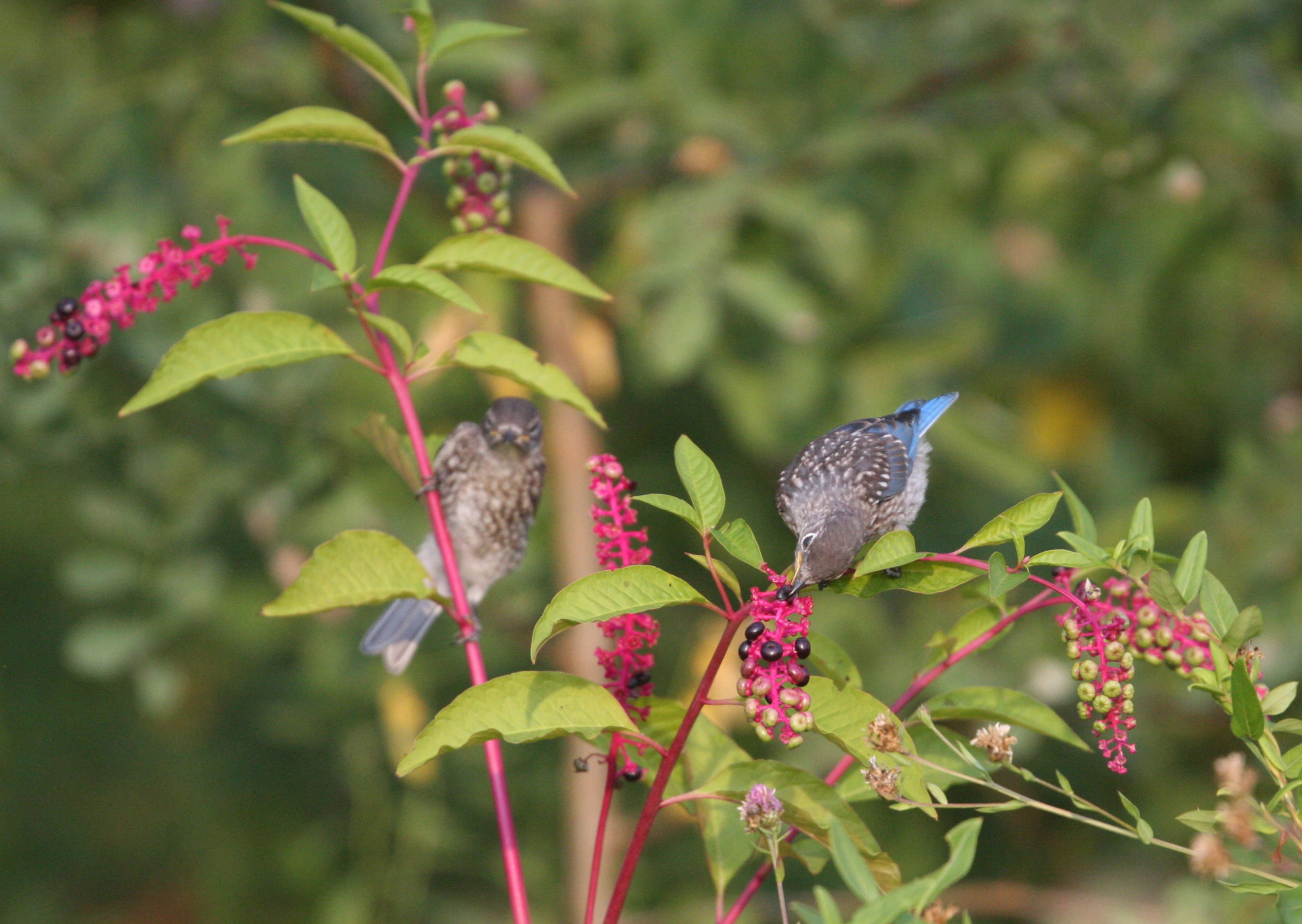![]() (House Centipede by Flickr user theilr)
(House Centipede by Flickr user theilr)
On Being Misunderstood is a new feature at The Metropolitan Field Guide which will look at the variety of flora and fauna we live with which are too commonly misunderstood. From plants to wildlife, many of our daily interactions with these species are often negative or confused. Many of these reactions are based on misinformation. This new feature seeks to combat these misconceptions by bringing in guest writers to explain some of these species to us so we all have a better understanding and to set the record straight.
If you would like to contribute to this series as a guest writer, contact me and let me know!

The House Centipede, Scutgera coleaptrata
By Julie Feinstein
It takes barely a moment of reflection to realize that centipedes are, in fact, innocent. They just have an unfortunate combination of features that scares us. To begin with, they are too fast for our comfort. According to the 1976 Guinness Book of World Records, the house centipede is the world’s fastest arthropod — about16 inches per second. House centipedes also seem to be unreasonably large. Although the body of a fully grown adult is only an inch and a half long, its threadlike antennae extend forward and its long legs extend backwards for a disturbing total length of about five inches. And their appearance is unpleasantly alien. An adult has 15 pairs of color-banded legs, three bold stripes running the length of its slender body, waving parts, mysterious purpose, and this alarming habit of leaping into view.House centipedes always seem to arrive suddenly. They dart into view with legs rippling and antennae waving. They run and stop, run and stop again. Humans snap to attention. Even gentle nature-loving people sometimes jump up to kill a centipede. The American author, William S. Burroughs, went so far as to say that a person who would stroke [pet] a centipede was a traitor to the human race.
House centipedes are sometimes called “hundred leggers” or even “thousand leggers.” That’s total exaggeration. Even the name centipede is misleading since it means hundred feet. An adult house centipede has just 30 legs. The number of legs alerts us that centipedes are not insects (which are all hexapods with six legs). Centipedes are myriapods, in the suborder Myriapoda, a group of many-legged arthropods that also includes millipedes and some obscure soil-dwellers.
House centipedes are not born with 30 legs. They start out with eight, one pair on each of four body segments behind the head. As they grow into successive stages, centipedes shed their skins like caterpillars. Each growth stage is bigger than the last and has a few more leg-bearing segments — four, then five, seven, nine, eleven, thirteen, and ultimately fifteen pairs of legs. The legs increase in length from front to back. The last pair is not used for locomotion; they are long and thin and may act like a pair of rear antennae. The first pair of legs is on the body segment just behind the head and functions as mouthparts. They are modified to deliver poison and are called poison claws; they are the centipede’s weapons.
House centipedes are nocturnal hunters that roam through our homes at night searching for prey. They eat spiders, flies, silverfish, moths, roaches, termites, bees, and wasps. So many of our enemies are on the centipede’s menu, you would think we would welcome them. They capture victims by pouncing on them and snaring them with their long legs, typically envenomating a victim to kill it, and then holding it with front legs to eat it. A scientist once reported watching a house centipede hunt at a light; it caught and killed a fly with a bite to the thorax, then killed another fly while still holding the first. A centipede can hold at least four victims in some of its many legs, to eat later, while it catches and eats others. They also have been seen beating on spiders with their front four or six pairs of legs.
It is time for me to admit to a fondness for cobweb spiders; I allow them to occupy a few corners of my home unmolested so I can watch them, and they catch and eat insects in return for the favor. It was inevitable that a centipede would one day meet my bathroom spider. The battle was short. The centipede won. I did not stay for the feast, but another scientist long ago described watching a centipede eat a spider: it ate the abdomen first in small bites, then it detached and ate each leg in turn, and discarded all eight spider feet. Picturing this scene can be made a little more ghastly if you know that centipedes wait for prey in silent stillness but while eating, they flutter their legs.
After dining, centipedes clean themselves. They have a grooming structure near the mouth. It’s a groove covered with hairs through which antennae and legs can be passed to remove dust and dirt. They clean their appendages from the base to the tip in a meticulous and unchanging order, starting with the antenna then legs on one side of the body, from front to back. After one side is done, they do the other. And they keep track; if interrupted while grooming, the centipede resumes where it left off. If a leg is missing, the centipede will try to clean it when its turn comes. It is inaccurate and unfair to call house centipedes dirty.
The North American house centipede is a Mediterranean native that has become a synanthrope in Europe, Asia, and North America. It can be found throughout the United States. It is one of a few thousand kinds of centipedes that we know of, and the only one we know of that can complete its entire life cycle indoors. Its life span is about three years, so it is theoretically possible to get to know individuals. Some people keep them as pets, with red lighting to illuminate nocturnal activities. If you are tempted to get to know a centipede better, please look without touching – for two good reasons.
First, although centipede poison claws are rarely able to penetrate human skin, that might not be absolute, and they will try to bite if they feel threatened. Allergic reactions and infections are possible.
Second, house centipedes sometimes defend themselves by abandoning legs in a defensive strategy called autotomy – like when a lizard’s tail breaks off. Dismembered legs thrash and twitch after being cast off, cleverly attracting the attacker’s attention to the leg while the centipede gets away. Scientists lament that it is difficult to collect intact centipede specimens for research because they are such fast runners and their legs keep falling off. Centipedes are able to begin repair right after a leg comes off; a drop of fluid is exuded and hardens quickly to form a kind of organic suture. The legs grow back, but replacement legs may be short or imperfect; it is better for the centipede to keep its original legs.
Centipedes do most of their hunting, fighting, cleaning, eating, and leg dropping at night while we sleep and the lights are off. They prefer to stay in dark places during the day. It is probably better that way for all of us. I close with a haiku I wrote for the occasion.
Sudden Centipede!
We stop and watch each other
Both ready to run.
 About Julie Feinstein – I am a Collection Manager at the American Museum of Natural History. I live in New York City. I write a blog about urban wildlife, with updates every Sunday. Click here to visit my blog: (http://www.urbanwildlifeguide.net)
About Julie Feinstein – I am a Collection Manager at the American Museum of Natural History. I live in New York City. I write a blog about urban wildlife, with updates every Sunday. Click here to visit my blog: (http://www.urbanwildlifeguide.net)
I recently published the book, Field Guide to Urban Wildlife.








Thank you for this fascinating piece. I came across one of these centipedes while visiting my father in Atlanta. Not knowing what it was I relocated it outside without losing a leg. I’ve never come across the house centipede in Florida, but would love to have one on patrol.
I love this new series…it will have me thinking twice!
im terrified of these things. i thought reading this article could help me understand them better.nope…still terrified as ever!
Me too! Im pretty positive I just found one in my room and I dont think ill be able to sleep now 🙁
I love the humour in you story!
The pictures! Noooooo!
Great article, but when I try to mellow my instinctive loathing of them, and then see those closeups, Gaaack! Back to the battlefront!
Seriously though, this is an excellent piece on these creatures. I’ve been wondering about them for a year now, ever since I found the first one seemingly waiting to ambush me in the bathtub, and now I see that they are actually beneficial.
Thanks!
Thanks for writing about these guys! I just observed a house centipede cleaning itself today and found this article while googling the behavior. It’s really neat to watch them be so particular about cleanliness since people often assume they’re dirty.
Pretty late in the day, but just thought you’d like to know that I have one of these living in my kitchen – seen for the first time tonight. I live in the north of England. Don’t think they’re very common here. I think it might be hunting woodlice. Or it might have come in with the male house spiders. It’s mating season for these big boys in the UK at the moment. Oh joy. More multi-legged monstrosity.
Awwwww, what a little cutie! Come to papa, come to papa, I’m gonna make a terrarium just for you and give ya yummy snacks! OMG! OMG! OMG! Look at that face, cuteness explosion!
Hello. I must say I thank you for the post about the centiped. When I was younger my dad told me they eat spiders not to kill them
After finding one on the wall I decided to investigate if they in fact do… thank you for sharing my? Chad
We had one visit our home today in southern Wisconsin. Definitely a beautiful creature…. Next time one visits we may just keep it in a terrarium. I was happy to see an article about them. Incidentally, we also have a bathroom spider. We named her Fido (because she seems to be the size of a small dog!)
i turned the apartment lights on and there it was. I didn’t have time to react. He shot across the wall like it was on fire. I haven’t seen him since. I know he keeps the place free of insects but it is still creepy. Good article.
Thanks for writing this. We had one in the kitchen. My mom just took it out!!!!!!:):):):)
I woke up with one in my mouth once. I had bitten down in my sleep while snoring and it almost disintegrated in my mouth. I ran to the washroom, looked in the mirror and its legs were all over my tongue. I’m forever traumatized by this.
I wish I could live harmoniously with them, but if I am aware of ones presence, I will do battle with it. Since I lack many many arms and legs to make it a fair fight, I utilize my superior technology. Thank goodness for my vacuum.
I too had a traumatizing experience. I got out of the shower one day and wrapped my towel around myself only to feel an odd wiggling sensation on my stomach. I looked and there it was, the centipede and legs crushed but still wiggling. I always shake out my towels rigorously now before using them..
I’m a person that hates the idea of using pesticides; I fear them. I’ve collected jumping spiders of many sizes and released them into my house for years, for the purpose of ridding it of undesirable creatures. I now want to begin collecting as I can, house centipedes to assist with this chore as I don’t find them repulsive and hope that the combination of both types of hunters will help do the job better.
I have a beared dragon that I feed crickets on a daily basis. One or two inevitably escape. This morning while cleaning my hallway I met one if these beautiful centipedes. I mistook it for a cricket at first, the hall was dark.
When I got ready to catch it, with my hands, I realized this is NOT a cricket. I have it in a plastic container and after reading your blog, I want to let it go inside my house, but it is a little creepy, just as it is fascinating.
I think I will relocate it to the basement, where most of my crickets end up at and pray it has a good life.
By the way, you said they only live three years, right? Is that 3 years after becoming an adult with all its legs or from birth? Lol.
Loved your article! Thank you for the detailed, light humored centipede post. After finding yet another house centipede (this particular one with flowing locks (legs) was nestled inside my sleep mask next to my bed. Gasp!), I decided to transfer it to a bathroom corner rather than force it to take a few laps in the toilet. I remember reading they like to dine on other indoor insects but I wanted to do some fact checking and found your piece. Alas, my house centipedes no longer need to fear being squashed; hunt away you creepy night creepers. But a warning to them and their offspring – stay off my bed and away from my sleep mask!
I dreamt about a centipede last night. They do scare me a bit. I usually meet up with them in the bathroom. In my dream I came upon it after I had just negotiated outdoor stairs without backs, another big fear of mine. There was a woman near me who was letting the centipede crawl on her. She seemed to be helping me be with my nervousness. It seems that my subconscious is sending me a message that it is time to let my fears surface so that I can move on with less inhibition. Maybe? Anyway I really enjoyed your article. I was laughing while I read it. Next time I come across a centipede I will acknowledge its presence with more lightheartedness and amazement. Thank you for helping me have a new perspective on this creature.